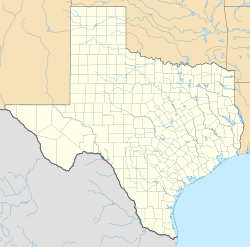Congress Avenue Historic District facts for kids
Quick facts for kids |
|
|
Congress Avenue Historic District
|
|

Downtown Austin and the State Capitol as seen from Congress Avenue.
|
|
| Location | Congress Ave. from 1st to 11th Sts., Austin, Texas |
|---|---|
| Area | 38.3 acres (15.5 ha) |
| Built | 1839 |
| Architect | Multiple |
| Architectural style | Late Victorian, Skyscraper |
| NRHP reference No. | 78002989 |
| Added to NRHP | August 11, 1978 |
Congress Avenue is a really important street in Austin, Texas. It's a wide, tree-lined street with six lanes. It goes right through the middle of Austin, from the far south all the way to the Texas State Capitol in downtown. It even crosses over Lady Bird Lake!
The part of Congress Avenue south of Lady Bird Lake is called South Congress, or often just SoCo. It's a super popular area for shopping and finding cool places to live. As it heads south out of town, it passes the historic Travis Heights neighborhood, the Texas School for the Deaf, and St. Edward's University.
Contents
History of Congress Avenue
How Congress Avenue Started
When the city of Austin was first planned in 1839, the idea was for Congress Avenue to be its main and most important street. Right from the start, buildings like government offices, hotels, shops, and restaurants began to appear along "The Avenue." By the late 1840s, it was already a busy business area.
Changes Over Time
In the mid-1870s, new things came to Congress Avenue. They added gaslights to make the street brighter at night. Also, mule-driven streetcars started running, making it easier for people to get around. A new courthouse was built at Eleventh Street. The famous Texas State Capitol building, which you can see at the north end of Congress Avenue, was finished in 1888.
The original dirt street was paved with bricks in 1910. Trolley cars, which were like electric streetcars, operated on the Avenue until 1940. Before Interstate 35 was built in the 1960s, Congress Avenue was the main road people used to reach Austin if they were coming from the south. Places like the Austin Motel show how important this road was for travelers in the middle of the 20th century.
What Does Congress Avenue Look Like?
Starting Point and Major Roads
Congress Avenue begins in south Austin, where it meets Slaughter Lane, not far from Interstate 35. From there, it heads north. This part of Congress Avenue, from Slaughter Lane to the Williamson Creek bridge, is maintained by the Texas Department of Transportation. It's even called Loop 275 here.
Traveling North Through Austin
After passing Stassney Lane, the road turns northeast and runs alongside I-35. Congress Avenue then goes over the US 290/SH 71 freeway, which locals call Ben White Boulevard. Continuing northeast, it passes by St. Edward's University and goes through the popular South Congress area.
Crossing Lady Bird Lake
Next, Congress Avenue crosses over Lady Bird Lake (which is part of the Colorado River) using the Ann W. Richards Congress Avenue Bridge.
Reaching the Capitol
The street continues northeast through downtown Austin until it reaches 11th Street at the Texas State Capitol. At the Capitol, the street splits. The lanes going north go around the east side of the Capitol, and the lanes going south go around the west side. This part of Congress, between 11th and 15th Streets, has been closed to cars since 2001.
Beyond the Capitol
The street then merges back into a two-way street northeast of the Capitol. It continues for a few more blocks before ending at the University of Texas at Austin campus, at Martin Luther King Jr Boulevard.
Ann W. Richards Congress Avenue Bridge and Its Bats
The Ann W. Richards Congress Avenue Bridge over Lady Bird Lake is home to the world's largest group of urban bats! When the bridge was fixed up in the 1980s, the new design accidentally created perfect little spaces underneath for bats to live.
In the summer, this bat colony can have as many as 1.5 million Mexican Free-tailed Bats. You can see thousands of them flying out from under the bridge every evening during the summer. They fly out to find food before they migrate to Mexico for the winter.
Why Congress Avenue is Special
Recognized for History and Architecture
Because of its important buildings and history, the part of Congress Avenue from Cesar Chavez Street (which used to be called First Street) all the way to the Capitol was added to the National Register of Historic Places in 1979. This means it's officially recognized as a special place in American history.
Protecting the View of the Capitol
The Capitol building stands at the very end of Congress Avenue, creating a beautiful view. This view is so important that it became one of the Texas Capitol View Corridors. These corridors are protected by state and local laws, which means no tall buildings can be built that would block the amazing view of the Capitol from Congress Avenue. This protection started in 1983.
Cesar Chavez Street is the former First Street.



